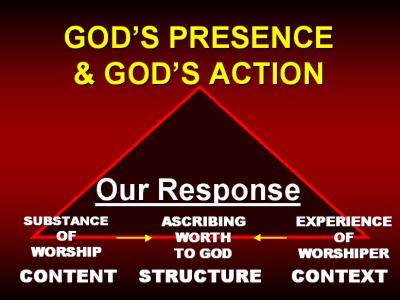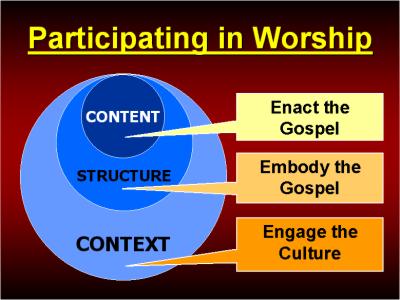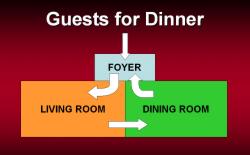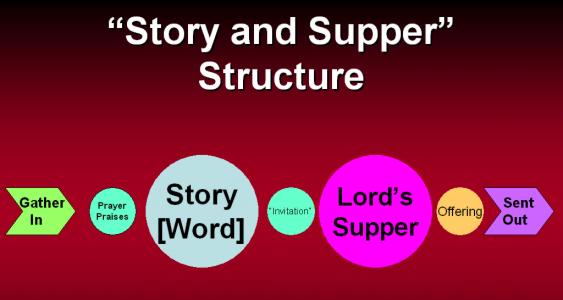 Review: Content, Structure, Context
Review: Content, Structure, Context
 Review: Content, Structure, Context
Review: Content, Structure, Context

Structure in Nature and Experience
Structure of trees (same but different)
Structure of human skeletons, human bodies (same but different)
Structure of time and seasons (Read Genesis 1:14-19) - In the creation of all things tangible and intangible
God is bringing structure to the shapeless and dark earth - [In the beginning when God created the
heavens and the earth, the earth was a formless void and darkness covered the face of the deep, while a
wind from God swept over the face of the waters - Gen. 1:1-2
Structure creates certain boundaries than define and shape objects and events. But within and around that structure there is still variation and uncertainty. This combination of unity and diversity is what makes something natural and wonderful. This is the secret that good musicians know. They can improvise, but they don't just play anything. They follow certain patterns, scales, and modes. Even musicians who cannot understand musical notation follow these structures. And even if an orchestra plays a very precisely laid out piece of sheet music, they must still interpret what it sounds like because there are so many variables in musical performance.
The combination of structure and variety is what makes sport and games interesting. Take March Madness and basketball as a current example. Basketball is a game with defined rules. We give a referee a hard time when he makes a bad call not simply because it is against our team, but because we know he is following the rules. We know the rules and we want him to enforce them - unless the bad call favors our side and then we ignore it! The referee is there because the players have to work within the rules and boundaries. But within those boundaries and rules there is opportunity for great variety, and chance, and play. (This is why predictable games or simple games are boring - there's no creative element). The tournament is another example of structure and variety. The tournament of 64 teams begins as a very precise structure. The #1 plays the #16, #2 plays #15, etc. and so on. Yet, the uncertainty and the mystery of it all that creates the great moments high and low - the thrill of victory and the agony of defeat!
Now let's go from the lesser to the greater. If there is such a wonderful and beautiful and combination of structure and variety, unity and diversity in nature and human experience, shouldn't we expect that we will find and even more wonderful combination in worship. I think we should. And if we ignore this, then we ignore the combination of structure and variety, unity and diversity that allows the human and the divine to intersect - what allows us to encounter God! As a result we reduce worship to a ritual or an obligation. Our worship has a structure because we are embodied creature. We are bound by time and space. But the God we praise is not limited in that way. Our worship embodies the gospel because the gospel itself is an intersection of the certain and the unexpected.
Consider the gospel event: Jesus is crucified, he is buried. Every explanation we give for that part of the gospel simply affirms the reality we know - we are sinful, we do not recognize God's love, there is suffering and cruelty in the world. But what part of the gospel event did I not mention? The resurrection! The resurrection is unexpected and surprising! It is mysterious and powerful! Now there is hope where we had none. Now there is possibility where previously we had despair. And it is all because of God and who he is. (See Romans 11:33-36, the precursor to our spiritual act of worship)
Our worship embodies this experience with a certain structure. But we cannot experience the depth and the riches of God's grace if we are just ticking off a list of worship duties. Those are just daily chores - [ Isn't it interesting that a child that will balk at doing routine chores and will finish those chores off only to go and submit himself or herself to the rules of a game with other children - or the rigid structure of a video game or the chapters of a book!] Without some understanding of how we "move" within the structure, we will miss the opportunities to encounter God and enact his gospel together.
 As an illustration, let's talk about what we do when we have guests over to our house for dinner. There are
certain structures that are basically the same no matter the occasion. And we can even think of these in
terms of movement through the rooms of a house . . . Foyer, Living Room, Dining Room. Consider the way
we talk and converse in each of these. We move and talk in appropriate ways as we move from the foyer
to the living room. Then we move in certain ways as we go from the living room to the dining room. In the
foyer we greet. In the living room we share news and tell stories. When do you bring up a serious subject?
Certainly not in the foyer! Whether it is a cookout, a formal dinner with new friends, or PBJ sandwiches
with old friends, we have these little conventions that allow us to commune. Why? Because we are
bodies, not shapeless minds floating thru space.
As an illustration, let's talk about what we do when we have guests over to our house for dinner. There are
certain structures that are basically the same no matter the occasion. And we can even think of these in
terms of movement through the rooms of a house . . . Foyer, Living Room, Dining Room. Consider the way
we talk and converse in each of these. We move and talk in appropriate ways as we move from the foyer
to the living room. Then we move in certain ways as we go from the living room to the dining room. In the
foyer we greet. In the living room we share news and tell stories. When do you bring up a serious subject?
Certainly not in the foyer! Whether it is a cookout, a formal dinner with new friends, or PBJ sandwiches
with old friends, we have these little conventions that allow us to commune. Why? Because we are
bodies, not shapeless minds floating thru space.
There is a basic structure of worship that enables us to encounter the God who is spirit and to commune with one another. Story and Feast. - Exodus 24:3-11 and Acts 2:42-47 demonstrates this basic structure.

The "field of play" (or boundary) for worship that embodies the gospel is, I suggest, sort of like a gravitational field. That is to say that it is the structure that orders the elements of worship in a natural structure that is sensitive to the gospel and our experience and we move through this field. We are shaped and order by it, even as we are allowed to move in it (like gravity). The structure of word and supper communicates our embodied similarities. It also enables us to embody the gospel and thus enact the gospel.
The gospel is real and so worship should be real. The death burial and resurrection of Jesus are real. It wasn't a myth or an act or a dream. God went through physical actions; he made a movement to show his love. And we do the same in worship and mission (discipleship). Our faith is not just something to agree with. It is an agreement that demands action. The images we use to describe our relationship (sheep and shepherd) are bodily, physical images. Just as our real baptism is a death and new birth.
Recommended Reading: I am indebted to Robert E. Webber for recognizing the Story & Feast structure of worship in both the Old Testament and New Testament. Dr. Webber has discussed this structure in many books and seminars. Among these is Worship Old & New, Zondervan, 1994.
 Link to next sermon
Link to next sermon
 Link to other sermons of Chris Benjamin
Link to other sermons of Chris Benjamin